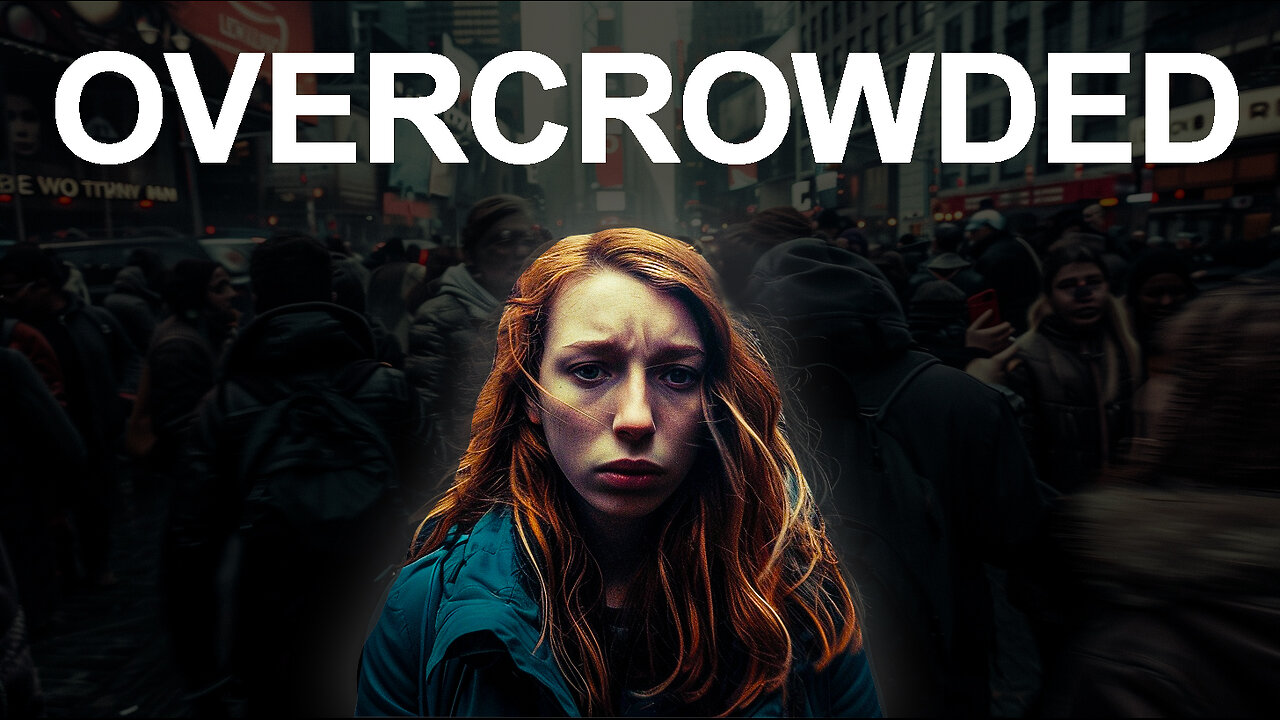Premium Only Content

Why Everybody Lives in these U.S. 10 OVERCROWDED Cities
In the vast expanse of the United States, there are certain cities that seem to exert an irresistible gravitational pull, attracting people from all walks of life.
These cities have become emblematic of the American urban experience, bustling metropolises teeming with energy, diversity, and opportunity. However, behind the glittering facades and towering skyscrapers lies a common thread: overcrowding.
In this exploration, we delve into the phenomenon of overcrowding in 10 prominent U.S cities, examining the factors that have led to their status as magnets for the masses.
New York City - Population: Approximately 8.7 million.
New York City, often dubbed the "Big Apple," stands as a beacon of ambition and aspiration for millions around the world. From Wall Street titans seeking to conquer the financial world to struggling artists pursuing their creative passions, New York City offers a stage for dreams to unfold, a place where the impossible seems achievable and the extraordinary feels within reach.
The average price of a one-bedroom apartment in Manhattan, the city's most coveted borough, is well above $3,000 per month, making it one of the most expensive rental markets in the world. Even in the outer boroughs like Brooklyn and Queens, where rents may be relatively lower, the cost of living remains daunting for many residents.
Beyond housing, the cost of utilities, groceries, and other necessities also contributes to the high cost of living in New York City. Utility bills for a typical apartment can easily exceed $200 per month, while groceries tend to be more expensive compared to other parts of the country due to higher operating costs for retailers. Additionally, the price of dining out and entertainment in the city can quickly add up, with a meal at a mid-range restaurant costing around $20 to $30 per person and tickets to Broadway shows averaging over $100 each.
Los Angeles - Population: Approximately 4.1 million.
Los Angeles, the entertainment capital of the world, exerts a magnetic pull on dreamers and strivers alike. With its sprawling metropolis, sun-drenched beaches, and thriving entertainment industry, LA embodies the quintessential American dream.
However, the allure of Hollywood glamour comes with a hefty price tag, as skyrocketing housing costs and gridlocked traffic plague the city. The average price of a single-family home in Los Angeles exceeds $800,000, making it one of the most expensive real estate markets in the country. Even renting an apartment in desirable neighborhoods like West Hollywood or Santa Monica can set you back thousands of dollars per month, with one-bedroom units commanding rents upwards of $2,000.
Beyond housing, the cost of living in Los Angeles extends to utilities, groceries, and transportation. Utility bills for a typical apartment can easily surpass $150 per month, while groceries tend to be more expensive compared to other regions due to the city's reliance on imported goods. Additionally, the city's infamous traffic congestion can result in long commutes and increased expenses for fuel and vehicle maintenance.
A meal at a mid-range restaurant typically costs between $15 to $25 per person, while upscale dining experiences can easily exceed $100 per person. Similarly, tickets to popular attractions such as Disneyland or Universal Studios can be quite expensive, often ranging from $100 to $200 per person.
Chicago - Population: Approximately 2.8 million .
Chicago, the Windy City, is a bustling metropolis nestled along the shores of Lake Michigan. From finance professionals navigating the bustling trading floors of the Loop to culinary artists crafting innovative dishes in trendy neighborhoods like Logan Square and Wicker Park, Chicago offers a diverse array of career paths and cultural experiences.
However, the city's allure is not without its drawbacks, as rising crime rates and socioeconomic disparities mar its reputation.The average price of a single-family home in Chicago hovers around $300,000, making it relatively more affordable compared to coastal cities like New York and Los Angeles. However, rental prices vary widely depending on location, with luxury apartments in downtown areas commanding rents well above $2,000 per month.
In addition to housing costs, residents of Chicago must contend with expenses such as utilities, groceries, and transportation. Utility bills for a typical apartment can range from $100 to $200 per month, while groceries tend to be moderately priced compared to other major cities. The city's extensive public transportation network, including the iconic "L" trains and buses, provides affordable options for getting around, although many residents still rely on cars, especially in the sprawling suburbs.
When it comes to dining out and entertainment, Chicago offers a diverse culinary landscape and vibrant nightlife scene. From world-renowned steakhouses like Gibsons and Chicago-style deep-dish pizza joints to trendy rooftop bars and jazz clubs, there's no shortage of options to satisfy every palate and preference. A meal at a mid-range restaurant typically costs between $15 to $30 per person, while upscale dining experiences can exceed $100 per person.
San Francisco - Population: Approximately 1.1 million.
San Francisco, the City by the Bay, is synonymous with innovation, creativity, and tech entrepreneurship.
At the heart of San Francisco's appeal lies its booming tech industry, which has propelled the city to the forefront of global innovation. From the headquarters of tech giants like Apple, Google, and Facebook in nearby Silicon Valley to the bustling startup scene in neighborhoods like SoMa and the Mission District, San Francisco serves as a magnet for software engineers, entrepreneurs, and venture capitalists seeking to make their mark on the world.
However, the city's tech boom has brought with it a housing crisis of unprecedented proportions. Skyrocketing rents and evictions have become all too common, displacing longtime residents and exacerbating income inequality. The average price of a single-family home in San Francisco exceeds $1.5 million, making it one of the most expensive real estate markets in the country. Even renting an apartment in the city can be prohibitively expensive, with one-bedroom units commanding rents upwards of $3,000 per month.
Beyond housing, the cost of living in San Francisco extends to utilities, groceries, and transportation. Utility bills for a typical apartment can easily surpass $200 per month, while groceries tend to be more expensive compared to other parts of the country due to the city's high cost of living. Additionally, the city's notoriously steep hills and limited parking make owning a car both impractical and expensive, prompting many residents to rely on public transportation or alternative modes of transportation like biking and ride-sharing.
When it comes to dining out and entertainment, San Francisco offers a diverse culinary scene and vibrant cultural landscape. From Michelin-starred restaurants serving up innovative cuisine to quirky cafes and food trucks dishing out local favorites, there's no shortage of options to tantalize the taste buds. A meal at a mid-range restaurant typically costs between $20 to $40 per person, while upscale dining experiences can easily exceed $100 per person.
Houston - Population: Approximately 2.5 million.
Houston, the Space City, sprawls across the Texas landscape, earning its nickname from its role as a hub for NASA's space exploration endeavors. Yet, beyond its celestial connections, Houston is renowned for its energy industry, diverse economy, and legendary Southern hospitality.
When it comes to housing, Houston offers a variety of options to suit different budgets and preferences. The average price of a single-family home in Houston is around $300,000, making homeownership more attainable for many residents compared to cities with higher housing costs. Rental prices are also relatively affordable, with one-bedroom apartments typically ranging from $800 to $1,200 per month, depending on the neighborhood and amenities.
In addition to housing costs, the overall cost of living in Houston is relatively low compared to other major cities. Utility bills for a typical apartment can range from $100 to $200 per month, while groceries and dining out expenses are also more affordable, thanks in part to the city's thriving culinary scene and diverse array of dining options. A meal at a mid-range restaurant typically costs between $10 to $20 per person, making it easier for residents to enjoy dining out without breaking the bank.
Miami - Population: Approximately 487,000.
Miami, the Magic City, exudes a vibrant energy that reflects its status as a melting pot of cultures and a playground for the rich and famous. Situated along the sun-kissed shores of South Florida, Miami is renowned for its multiculturalism, pulsating nightlife, and tropical climate that beckons visitors from around the globe.
However, Miami's rapid gentrification and income inequality have cast a shadow over its sun-drenched streets. As luxury condominiums and upscale developments reshape the city's skyline, many longtime residents find themselves displaced, unable to afford the soaring housing costs and property taxes that accompany Miami's real estate boom. The average price of a single-family home in Miami exceeds $500,000, while rental prices for apartments in desirable neighborhoods like South Beach and Brickell can easily surpass $2,000 per month.
In addition to housing costs, the overall cost of living in Miami is higher than the national average, driven in part by the city's reputation as a playground for the wealthy. Utility bills for a typical apartment can range from $150 to $300 per month, while groceries and dining out expenses tend to be more expensive compared to other parts of the country. A meal at a mid-range restaurant typically costs between $20 to $40 per person, while upscale dining experiences can easily exceed $100 per person.
Seattle - Population: Approximately 767,000.
Seattle, the Emerald City, stands as a testament to the majesty of the Pacific Northwest, boasting natural beauty that rivals any other metropolis in the world. Yet, beyond its scenic splendor, Seattle is also known for its vibrant tech industry, progressive values, and thriving cultural scene, making it a magnet for those seeking both career advancement and a high quality of life.
From software developers coding away in the bustling tech hubs of South Lake Union and Bellevue to outdoor enthusiasts exploring the region's countless parks, trails, and waterways, people from all walks of life flock to Seattle in search of adventure and opportunity.
However, Seattle's rapid growth has brought with it a host of challenges, including skyrocketing housing costs, traffic congestion, and homelessness. The average price of a single-family home in Seattle exceeds $800,000, making it one of the most expensive real estate markets in the country. Even renting an apartment in the city can be prohibitively expensive, with one-bedroom units commanding rents upwards of $2,000 per month in desirable neighborhoods like Capitol Hill and Queen Anne.
In addition to housing costs, the overall cost of living in Seattle is higher than the national average, driven in part by the city's booming economy and affluent population. Utility bills for a typical apartment can range from $100 to $200 per month, while groceries and dining out expenses tend to be more expensive compared to other parts of the country. A meal at a mid-range restaurant typically costs between $15 to $30 per person, while upscale dining experiences can easily exceed $100 per person.
Atlanta - Population: Approximately 536,000.
Atlanta, the Gateway to the South, is a bustling metropolis known for its cultural diversity, Southern charm, and burgeoning film industry. With its thriving economy, affordable housing, and warm climate, Atlanta offers a compelling destination for those seeking opportunity and affordability. From aspiring filmmakers to corporate executives, people flock to Atlanta in search of career advancement and a high quality of life. However, the city's rapid growth has led to traffic congestion, urban sprawl, and socioeconomic disparities.
Boston - Population: Approximately 724,000.
Boston, the Cradle of Liberty, is a historic city known for its intellectualism, innovation, and world-class universities. With its cobblestone streets, prestigious colleges, and thriving healthcare industry, Boston offers a unique blend of old-world charm and cutting-edge technology. From students to biotech professionals, people flock to Boston in search of academic excellence and career opportunities. However, the city's high cost of living and harsh winters pose challenges for many residents.
Washington, D.C. - Population: Approximately 752,000.
Washington, D.C., the nation's capital, stands as a dynamic metropolis at the intersection of political power, cultural richness, and international influence. From the imposing columns of the Capitol Building to the stately memorials that line the National Mall, D.C. exudes a sense of history and grandeur that is unmatched.
From seasoned politicians shaping the course of the nation's future to lobbyists navigating the intricacies of Capitol Hill, Washington is a magnet for those seeking career opportunities and civic engagement. The city's thriving job market encompasses a diverse array of industries, including government, law, finance, and technology, providing ample opportunities for professional growth and advancement.
However, the city's high cost of living poses challenges for many residents, particularly those in lower-income brackets. The average price of a single-family home in Washington, D.C. exceeds $700,000, making homeownership a distant dream for many aspiring residents. Rental prices for apartments in popular neighborhoods like Dupont Circle and Georgetown can be equally daunting, with one-bedroom units commanding rents upwards of $2,000 per month.
In addition to housing costs, the overall cost of living in Washington is higher than the national average, driven in part by the city's transient population and high demand for goods and services. Utility bills for a typical apartment can range from $150 to $300 per month, while groceries and dining out expenses tend to be more expensive compared to other parts of the country. A meal at a mid-range restaurant typically costs between $20 to $40 per person, while upscale dining experiences can easily exceed $100 per person.
Conclusion.
In conclusion, the phenomenon of overcrowding in these 10 U.S cities can be attributed to a combination of factors, including economic opportunities, cultural attractions, and quality of life considerations. While each city has its unique appeal, they all share common challenges such as rising housing costs, traffic congestion, and socioeconomic disparities. Addressing these challenges will require innovative solutions and collaborative efforts from government, businesses, and communities. Nevertheless, the allure of these bustling metropolises continues to draw people from all corners of the country and the world, reaffirming their status as magnets for the masses.
-
 LIVE
LIVE
Pop Culture Crisis
1 hour agoBonnie Blue BANNED, Tradwife Nara Smith BULLIED, Actress FAKES Brain Cancer?! | Ep. 856
668 watching -
 LIVE
LIVE
Akademiks
3 hours agoDiddy Trial Day 23: Kanye West Shows up to Support DIDDY n CONFRONT JANE DOE Day 5/30
2,173 watching -
 59:56
59:56
Crypto Power Hour
9 hours agoCrypto Trading With GROK
1.81K3 -
 LIVE
LIVE
Jeff Ahern
1 hour agoFriday Freak Out with Jeff Ahern
106 watching -
 15:17
15:17
Russell Brand
2 hours agoIt's about time...
29.6K52 -
 LIVE
LIVE
StoneMountain64
3 hours agoPUBG is truly INCREDIBLE
606 watching -
 LIVE
LIVE
Spartan
2 hours agoPro Halo Player | Scrims vs FaZe @ 3 EST then Ranked and/or SWTOR
37 watching -
 6:38
6:38
Talk Nerdy Sports - The Ultimate Sports Betting Podcast
3 hours agoNBA Finals Game 4 + MLB Sharp Card | June 13 Picks That PRINT 💰
1.6K -
 34:48
34:48
ArturRehi
4 hours agoRussia has taken 1 000 000 CASUALTIES in Ukraine! Russian Army Suffers! Ukrainian Update
931 -
 29:29
29:29
The Brett Cooper Show
1 day ago $5.41 earnedLA Is On Fire & Gay Celebrities Turn Straight For Pride Month | Episode 39
18.5K19